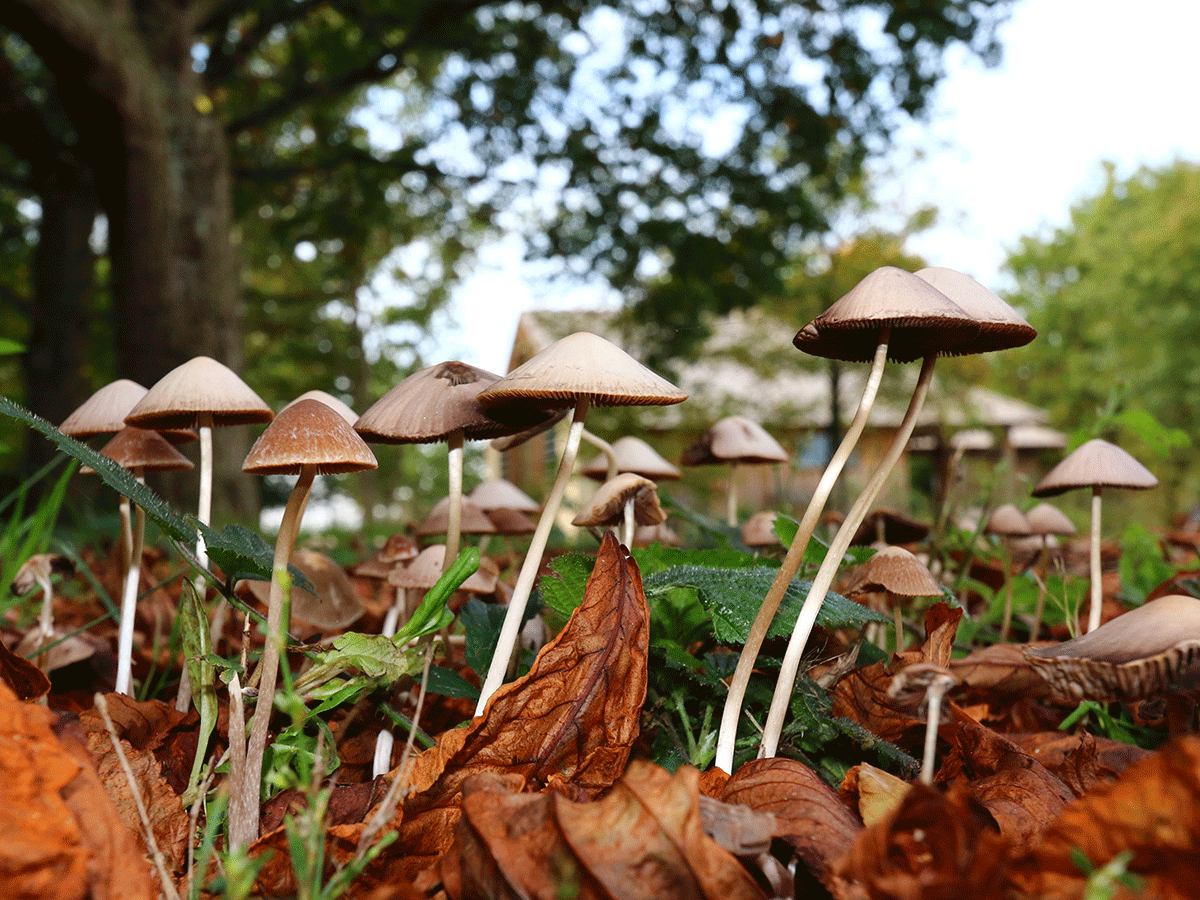Magic Mushrooms for PTSD: Why Psychedelics May Help Heal Trauma

Psychedelic-assisted therapy, including the use of "magic mushrooms," may aid in the treatment of PTSD, research suggests.
Post-traumatic stress disorder (PTSD), a naturally occurring response to trauma, is difficult to treat. It can be painful to remember—and process—the deeply disturbing events that have happened in our past. However, in recent years, the idea of treating serious, pervasive trauma with psychedelic drugs has become more common. Positive outcomes seen in some psychedelic-assisted therapy studies suggest that they may have the potential to advance treatment options.
Psychedelics are being explored as a viable treatment for a variety of conditions, including PTSD, addiction, marital strife, autism and depression, according to a 2017 study in the Journal of Psychoactive Drugs. These psychoactive drugs, once perceived as a threat to mental stability, are emerging as a possible way to achieve it and possibly cope with trauma. (See what puts you at high risk of PTSD.)
What is PTSD?
PTSD is a mental health condition that can be triggered—either by experiencing it firsthand or through witnessing—a range of disturbing events such as sexual abuse, physical assault, accidents, or any type of violence, according to the Anxiety and Depression Association of America (ADAA). It’s not uncommon for people who have served in the military to develop PTSD. Childhood trauma may also put an individual at a higher risk of PTSD. Typical symptoms of PTSD include heightened anxiety, flashbacks, nightmares, a sense of re-experiencing past events, feeling anxious or on edge, and depressed mood. PTSD can last for years, erode relationships with friends, family and coworkers and severely impact their overall quality of life. Women are twice as likely as men to develop this condition.
Why is it so hard to treat?
There are variety of treatments for PTSD—cognitive behavior therapy (CBT), prolonged exposure (PE) therapy, and other therapies that similarly involve the processing of traumatic experiences, which are the gold standard, says Matthew Johnson, PhD, associate professor of psychiatry at Johns Hopkins University School of Medicine, a principal investigator of multiple psychedelic research studies and an expert on addiction and risk behavior. “The problem with prolonged exposure therapy, which helps you confront your trauma triggers, is that it requires a lot of clinical engagement,” Johnson says. (Check out what your brain looks like with PTSD.)
Because symptoms of PTSD can cause problems with trust, closeness, communication, engagement is doubly challenging for people with PTSD. To put it simply, says Johnson, “It’s difficult to talk about trauma. That’s why adherence tapers off and drop off rates are high.” The length of time needed, along with the cost, can make existing therapy protocols less accessible as well. Experts estimate that some 30 to 40 percent of people suffering from PTSD don’t get sufficient relief from existing treatments, including cognitive behavior therapy, group therapies, and antidepressants. There are also shorter therapy protocols, like cognitive processing therapy, that are becoming more available. Medication can also be useful in the treatment of PTSD.
Why now?
The shortcomings of currently available treatments make the development of new PTSD treatments a research priority. Public need, alongside data that are compelling in terms of possible effectiveness, is generating more receptivity for drugs previously branded as controversial at best, mental health-damaging at worst.
The recent best-selling book by author Michael Pollan, How to Change Your Mind: What the New Science of Psychedelics Teaches Us About Consciousness, Dying, Addiction, Depression, and Transcendence, has also been a major player in what’s become a curiosity about psychedelics.
In 2017, a phase III clinical trial of the use of MDMA (or 3,4-methylenedioxy-methamphetamine, a psychoactive drug that alters mood and perception and is the basis of illicit drugs like Ecstasy or Molly) to treat PTSD got fast-tracked after it won U.S. Food and Drug Administration (FDA) designation as a potential “breakthrough therapy.” “In previous research, the improvements were so dramatic,” says Johnson, “that two-thirds of people will look like they no longer meet the clinical criteria for PTSD a year after treatment. Even if large-scale trials can only demonstrate an effectiveness rate of half that, it’s much better than anything available currently.”
So although there are FDA-approved medications currently used by psychiatrists and other doctors to help treat PTSD, old biases about psychedelic drugs are now being questioned as research has suggested that they might be helpful in the treatment of psychiatric conditions.
What are psychedelics, exactly?
Psychedelics are mind-altering substances in a class of drugs called hallucinogens, which cause people to have vivid experiences of things that appear to be real but are, in fact, created by the mind. A psychedelic-induced experience can last as long as 12 hours, says the National Institute on Drug Abuse (NIDA). Over 100 species of mushrooms contain psilocybin, the active compound which gives them the colloquial name “magic mushrooms.” A number of manmade hallucinogens, such as MDMA and ketamine, are known by their previous claim to fame—as a central component of dance parties and “rave culture.”
How does psychedelic-assisted therapy work?
“It’s not just the direct effects of psychedelics on the brain that make the treatment so powerful,” says Johnson. “Similar to effective therapies like PE, exposure and reprocessing of the trauma is essential. But the addition of psychedelics is more likely to significantly speed up the therapy. The drugs amplify what we think works best.” Instead of eight to 15 sessions, the suggested course of therapy for CBT or PE, psychedelic associated therapy has only two to three sessions, although these sessions are bookended by several non-drug sessions.
MDMA and psilocybin can also intensify the rapport one has with one’s therapist, which many experts believe is just as critical to healing, if not more, than the type of therapy being done. Researchers believe these drugs flood the brain with hormones and neurotransmitters that evoke feelings of trust. The theory is that this sense of trust comes from the relationship with the therapist, also referred to as a “guide.” Set and setting, buzzwords of the therapy, refer to this orientation of using drugs with a clear therapeutic intention: Set is short for “mindset” and setting is the physical and social environment in which the drugs are consumed, according to a 2017 study in Drug Science, Policy and Law. Set and setting, when combined with psychedelics, allows patients to re-examine traumatic memories with an unparalleled level of safety and well-being.
Along with rapport, psychedelic-assisted therapy, says Johnson, puts a damper on an overactive emotional response to the source of trauma. In other words, you can confront the trauma without being triggered by it. The combination of the reduced reactivity and the bond formed with one’s guide brings about what may be the crux of the treatment: An increase in self-empathy, which Johnson describes as the participant feeling more compassion for themselves, and less self-blame. Note, the doses used are significantly smaller than those used in the context of recreation or an attempt to get high.
When will it be legal?
Many experts believe that it may not be long before psilocybin is legally available, one way or another, in various parts of the globe. Johnson believes these estimates are overly optimistic, given the time needed for public input and safety regulations. He predicts it will become legal in between five to 10 years. But progress is moving forward, at least in terms of decriminalization. Denver voted in May to become the first city to decriminalize psilocybin. For Johnson, the future holds the promise that psychedelic-assisted therapy will be considered a first-line of treatment for a range of conditions beyond PTSD, including depression and addiction.
What can you do in the meantime?
It’s important to see these drugs as just one aspect of an ongoing psychotherapy process. CBT and PE are still considered the most effective treatment for PTSD. Over time, these treatments can change how you think about your experience—your perspective. While re-exposure to the trauma can be inherently difficult, gradual doses of exposure can make re-experiencing it more digestible, says Johnson. “My advice is to find professional care and don’t give up. If you don’t stay in treatment, you are less likely to get better.” Training in mindfulness and anger control skills can also help with coping, as can support from family and friends. Exercise and relaxation can also help reduce stress.
A final caveat: While both MDMA and psilocybin show promise for hard-to-treat psychiatric disorders, self-treating with these drugs is ill-advised. The conditions in the studies mentioned were strictly controlled and the patients meticulously monitored during treatment. According to the NIDA, MDMA, in particular, has been linked to health risks such as drugged driving and depression. Despite the hype that surrounds this therapy, many experts believe that some people should never take psychedelics at all.
Medically reviewed by Ashley Matskevich, MD.
Next, learn how exercise can help relieve stress.




